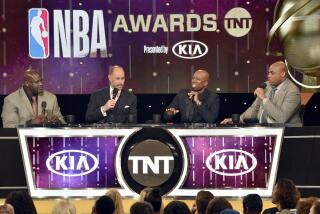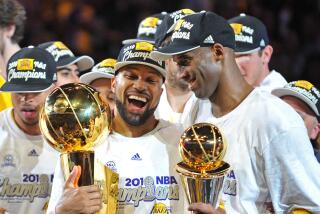Two to Tango
- Share via
Why this is still possible:
Shaquille O’Neal and Kobe Bryant.
In sports, being good enough means never having to say you’re sorry and being great means no one will care if you make sense or even speak the language.
Being the Best Ever, which the Shaq-Kobe tandem could become?
It means you can have a season-long snit, put everyone around you through hell, get it together a week before the playoffs, accuse the media of making it up and still have time to mount a meaningful defense of your NBA title, as the Lakers now hope to do.
At midseason, amid reports of their latest standoff, Turner’s Danny Ainge likened it to asking Michael Jordan to play with Wilt Chamberlain.
Now that Shaq and Kobe seem to be in a better place the question becomes:
If Jordan and Wilt had gotten along, who could have possibly dealt with them?
Make no mistake, if Shaq and Kobe aren’t already the best tandem ever, they’re on the list.
“I think they compare very favorably,” said ESPN’s Jack Ramsay, whose NBA service dates from the ‘60s.
“The amazing thing about both of these guys is, they’re both still in their prime,” says new Wizard Coach Doug Collins, who arrived in the ‘70s. “They’re still young. There’s so much ahead of them.”
What they have already done isn’t bad. In Bryant’s second season as a starter, he and O’Neal won a title. In this, Bryant’s third, Shaq (28.7) and Kobe (28.5) combined for 57.2 points a game.
In 1961-62, the Lakers’ second season here, Elgin Baylor (38.3) and Jerry West (30.8), generally considered the most explosive tandem ever, combined for 69.1.
That season, the Philadelphia Warriors’ Chamberlain and Paul Arizin established the two-man record, 72.3. Of course, Wilt got 50.4 of those while Arizin, an aging jump shooter in his last season, added 21.9, which is why no one talks about the Wilt-Arizin tandem.
Factoring in the NBA’s radical loss of offense over 39 seasons, Shaq and Kobe are within 0.4 of a point of basketball’s Paul Bunyan and his helper.
Adjusting for the 20% drop from 118.8 points a game in 1962 to 94.7 this season, the Wilt-Arizin total becomes 57.6 and the Baylor-West total becomes 55.1.
However, a tandem’s impact involves not only scoring but defense, the ability to complement each other and win titles, measured over time.
The one test O’Neal and Bryant haven’t surmounted is that of time. As their history suggests, for Shaq and Kobe, basketball is easy and everything else is the problem. For what could be the greatest tandem of all, the challenge begins with remaining a tandem.
*
Until recently, the history of great NBA teams was not the history of great tandems.
The great Celtic dynasty of the ‘50s and ‘60s was more of an ensemble production.
So were Wilt’s two overpowering teams, the ’67 76ers and the ’72 Lakers, which set records for victories en route to title romps.
The Showtime Lakers, who won five titles in the ‘80s, and the Celtics, who won three, had great 1-2 punches (Magic Johnson and Kareem Abdul-Jabbar, Larry Bird and Kevin McHale) but they also had such Hall of Fame No. 3 options as James Worthy and Robert Parish.
By the ‘90s, the salary cap began to bite and even great teams no longer brought first-line players like Michael Cooper, Bill Walton and Bob McAdoo off the bench.
The ‘90s marked the arrival of the first tandem-driven dynasty, the Bulls of Michael Jordan and Scottie Pippen.
They were succeeded by another tandem-driven champion, the Tim Duncan-David Robinson Spurs in 1999 . . . then by the Shaq-Kobe Lakers in 2000.
This isn’t science but opinion, which is why I can suggest a list of the greatest tandems:
1. Jordan and Pippen. The champs, six times over.
Jordan was definitely the senior partner, but Pippen was a highly skilled assistant, establishing himself as the prototype of a new kind of player, the 6-foot-7, do-everything-including-run-the-offense forward.
Playing second fiddle was a problem . . . until Jordan left and Pippen learned he didn’t like being The Man. After Jordan came back, they got along effortlessly.
How great were they? How about six titles in their last six full seasons, a 203-43 record in their last three and a 90-26 postseason record in their title runs, with journeymen manning the center position?
2. O’Neal and Bryant. The world should be their oyster if . . .
In size, athleticism and skill level, there has never been anything like them.
Shaq, 29, is the neo-Wilt. Ramsay, who was Chamberlain’s general manager in Philadelphia in the ‘60s, says Shaq is better.
Bryant, 22, is generally considered the game’s best all-around player.
“It’s interesting,” says Collins, “but you take Shaq and Kobe--first of all, two very talented players. Two very intelligent players. Two guys who want to win. And they’re tailor-made for each other because Kobe needs the dominance of Shaq inside to be able to do the things he does.
“Shaq, with his struggles at the free-throw line, although he’s shooting them better, Kobe’s the kind of guy in the last five minutes of the game, takes the pressure off Shaq. . . . Regardless of who plays with Shaq, they’re always going to need somebody at the end of the game who can work against the shot clock, make those kind of plays and get to the free-throw line.
“And Kobe--you can never have too dominant of a guy inside that makes your life easier.”
The interesting part is that two players so tailor-made for each other should have such trouble working out their relationship.
Basketball is one thing, chemistry another. As far as chemistry goes, they still have a little something to work on.
3. Johnson and Abdul-Jabbar. Talk about made for each other, the greatest point guard meets the greatest low-post threat.
They were just as complementary off the floor. Magic loved the spotlight and Kareem hated it.
Nevertheless, it took five years for them to go from associates to friends. Difficulties included the time Magic confided to the Herald Examiner’s Rich Levin that when Kareem left, they’d really see “the Magic show.” Levin wrote it without identifying the source, causing young Coach Pat Riley to call a team meeting and demand to know who the rat was.
In 10 seasons together, Magic and Kareem appeared in seven finals and won five titles, despite the presence of another legitimately great team, the Celtics.
One can only wonder how many titles they might have won if Abdul-Jabbar had been younger than 32 when Johnson arrived.
4. Bird and McHale. Greatest pair of forwards ever.
Bird was the most complete offensive forward who played, transcending the position as Johnson, his archrival, transcended guard. McHale was a low-post cult figure, so admired by opponents, they broke his repertoire down, frame by frame, to see how he did it. Their frontline in 1986, with Parish, backed up by Walton, was one of the best ever.
Bird and McHale never feuded but had their differences. As Bird’s biographer, the Boston Globe’s Bob Ryan, once noted, “Larry thought Kevin should work harder. Kevin thought Larry should get a life.”
5. Duncan and Robinson. They weren’t the first Twin Tower tandem, just the best.
No big-man tandem ever had such a combination of skills. Both can score in the high post or the low post, defend, handle the ball and run the floor.
Robinson, now a shadow of himself on offense, acknowledges it was hard giving up his franchise-player role but did it without protest. If he hadn’t interrupted a Hawaiian vacation last summer to fly home and talk to Duncan, Duncan might be in Orlando, starting a new tandem with Grant Hill.
Like O’Neal and Bryant, they have only to meet the test of time. The problem is, Robinson turns 36 this summer . . . and Shaq and Kobe are in the way.
6. Baylor and West. They never had a good center, couldn’t beat Bill Russell’s Celtics in six finals, never won a title. Irony of ironies, West broke through in 1972, six months after Baylor retired.
Nevertheless, for firepower and artistry, they were something, taking their teams to seven finals and popularizing the game here.
West was in only his second season, and his first full one as a starter, when they peaked at 69 points. Still shy, he had to step up with Baylor sitting out 34 games because of military reserve obligations.
The next season, Baylor, coming off averages of 34, 38 and 34, began experiencing the knee trouble that slowed him to merely great his last 10 seasons, or he and West might have gotten a ring of their own for all that virtuosity.
7. Karl Malone and John Stockton: Seventeen seasons later, 14 as starters, they haven’t won a title but they’re still in the hunt.
They’re not popular with peers, what with Stockton setting picks on bigger guys in the lane and Malone bulldozing them when he isn’t flopping to get calls. But, as professionals, what can you say but: Wow!
File under What Might Have Been: Toronto’s Vince Carter and Tracy McGrady (they’re cousins and lasted only two seasons); Seattle’s Shawn Kemp and Gary Payton (supposedly the next Mailman and Stockton); Minnesota’s Stephon Marbury and Kevin Garnett (ditto).
Time is fleeting, no matter how young one is, and chances at this kind of thing are few.
(BEGIN TEXT OF INFOBOX / INFOGRAPHIC)
Terrific Tandem
Shaquille O’Neal and Kobe Bryant are arguably the best players in the NBA. Their statistics the last two regular seasons:
*--*
1999-2000 Shaq Kobe Points 29.7 22.5 Rebounds 13.6 6.3 Assists 3.8 4.9 2000-2001 Shaq Kobe Points 28.7 28.5 Rebounds 12.7 5.9 Assists 3.7 5.0
*--*
More to Read
All things Lakers, all the time.
Get all the Lakers news you need in Dan Woike's weekly newsletter.
You may occasionally receive promotional content from the Los Angeles Times.








